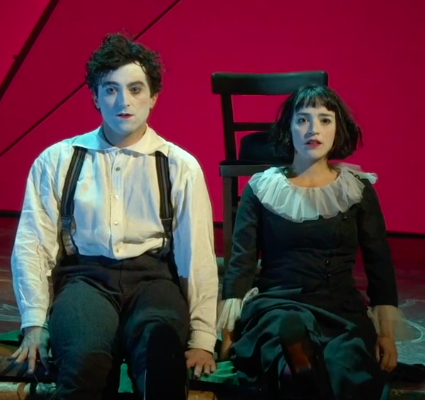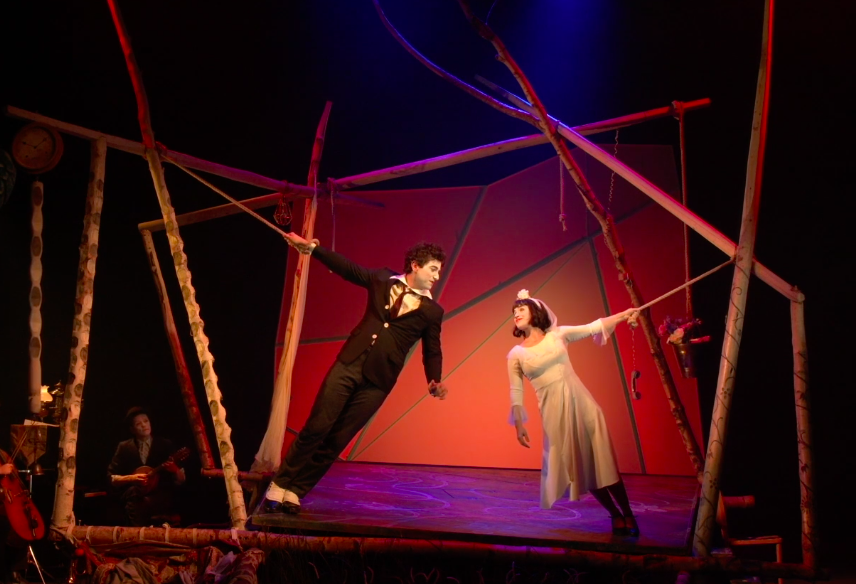The Flying Lovers of Vitebsk” Is the Poignant, Powerful Imagining of the Marc Chagall Story: A New Jewish Classic
By Sue Weston and Susie Rosenbluth – Two Sues on the Aisle
It has been said that the beloved Jewish artist, Marc Chagall, and the 20th century were made for each other. “The Flying Lovers of Vitebsk,” a four-year-old gem of musical theater, based on the love story between the artist and his poet wife, Bella, proves that Chagall and his story were also made for the 21st century and probably forever.
Written by Daniel Jamieson with music by Ian Ross, “The Flying Lovers of Vitebsk” premiered at the Bristol Old Vic. Directed by Emma Rice, this fantasy fairytale love story has been beautifully configured for Zoom audiences, many of whom enjoyed it when it was shown recently by the glorious Charleston, South Carolina-based Spoleto Festival.
The piece takes it name from the Lithuanian city in which Chagall was born in 1887 and for the relationship memorialized in countless of his paintings featuring himself and Bella Rosenfeld, the woman he met in 1910 when she was little more than a girl and married in 1915 when he returned to Vitebsk after spending several years pursuing his artistic career in Paris.

Marc (Marc Antolin) and Bella Chagall (Audrey Brisson)
Partners on Canvas and in Life
With whimsical sets inspired by Chagall’s paintings, the theatrical journey begins in 1914 in Russia, depicted on a minimalistic stage that frees the imagination to see green cows and flying rabbis through the eyes of the young couple forced to flee their war-ravaged home.
While at first glance, they seem as mismatched as a Chagallian rooster floating above a city with a bride on his back, Marc, the eldest of ten children of a poor Chassidic family of merchants, and Bella, the brilliant child from a wealthy family of jewelers, serve as the almost cojoined characters in the artist’s rich dreamlike story in which things are not quite what would be expected in the daylight: unrealistic but not abstract, incredible but not unbelievable, realistic but not reasonable.
“The Flying Lovers of Vitebsk” captures Marc and Bella as partners in life and on canvas, immortalized as the picture of romance, floating over a Russian village or the Eiffel Tower. But although they are often seen flying on canvases, in life they sloughed through some of the most devastating years of Jewish history, navigating pogroms, the Russian Revolution (and its antisemitic aftermath), and the Holocaust.
The piece’s references to pogroms, the hanging of a police officer, soldiers overtaking streets, and the constant static of gunfire are a reminder of the war taking place in the background.
When pogromchiks ask Chagall, “Jew or not?” his response is “no.” “I so wanted to live,” he tells the audience, relieved when his tormenters shout, “All right. Get along.”

“The Flying Lovers of Vitebsk” uses a minimalistic stage
Theater Imitating Art
Throughout the presentation, the troupe, consisting of Marc Antolin (who remarkably resembles the self-portraits of Marc Chagall, especially in the works that include Bella), Audrey Brisson (whose facial expressions and mannerisms make her the Bella of Chagall’s work), and musicians (Mr. Ross and James Gow) sparkles with chemistry.
Captivating dance sequences not only exude originality, such as the wedding scene in which Marc and Bella actually wear chairs, creating the illusion of being carried, they also seek to duplicate their positions on canvas, such as the image of Bella putting birthday flowers into a vase as her lover flies off the ground, craning his neck in a 180-degree angle to plant a kiss on her lips.

Wearing Chairs to create the illusion of being carried
The small cast is packed with talent, moving the story forward with song, dance, and pantomime. For those familiar with Chagall’s work, it is a joy to see his images, such as Candlestick with the Burning Lights, Cow and Fish Playing Violin, and the Man Meditating on the Scripture come to life. Even the costumes used in the production leap onto the stage from the canvases.

Chagall’s images come to life
Victims of Antisemitism
The story takes Marc from Vitebsk to Paris, where his work attracts international attention, culminating in a successful exhibition in Berlin, only to collapse when World War One makes association with Jews undesirable.
The “Flying Lovers of Vitebsk” understands the brutality of World War One, but it more clearly recognizes the effect it had on the already vulnerable Russian-Jewish community. Being Jewish, more than being Russian, shaped Chagall’s life. It dictated where he would work, study, and succeed. It defined his mobility and dictated whether his work would sell or not.
In “The Flying Lovers of Vitebsk,” Chagall returns poverty-stricken to his hometown, not because his work didn’t sell on the continent (it did), but because he was swindled by agents and customers.
Communist Antisemitism
Back in Russia, Marc and Bella struggle to strike a balance between their love of family, his artistic expression—and hers in poetry, which is often overlooked next to the enormity of his paintings—and national pride in being part of the developing Communist country. When Bella’s family home is defiled, their possessions confiscated by the Soviet government, Marc can seek comfort in his art, but he lashes out at his wife, telling her he is successful because he focuses on his creation, while she splits her time and ultimately forgoes her own artistic achievement in favor of his.
Although Chagall is appointed a Commissar for Art with his own People’s Art School, the communists misunderstand his work, and the school closes. Penniless, the family is forced to leave Vitebsk, never to return, not even when his father dies and they cannot afford a gravestone.
He can find employment only as the stage designer for the newly formed State Jewish Chamber Theater in St. Petersburg. It is there that their daughter, Ida, is born. And while today his pieces for the theater are considered masterpieces (forerunners of the gigantic murals overlooking the fountain at Lincoln Center in Manhattan), at the time, they were denigrated.
Victim of World War II
In 1922, the Chagall family leaves Russia for the continent, living in Berlin and Paris before they feel compelled by the growing Nazi danger to immigrate to the United States in 1941. The historic record shows that the Chagalls reached New York after Ida and the director of the Museum of Modern Art, Alfred H. Bar, Jr, added Chagall’s name to the list of European artists in need of asylum.
Bella died in 1944 in New York. In “The Flying Lovers of Vitebsk,” Chagall’s devastation at her death due to streptococcus is overwhelming. A victim of the Second World War, she died because soldiers needed the entire supply of penicillin.
Chagall went on to remarry, and his artistic output was prolific, but, as the theatrical piece makes clear, Bella remained his soulmate, forever eating fish balls with him, connected like a pair of opera glasses.
A Sui Generis Artist
Had Chagall not been a Jewish artist, robbed of the proceeds from his works and shunned by the Russians, would his art have reached higher recognition? It’s hard to imagine. Over the years, various critics have associated his work with Primitivism, Cubism, Fauvism, Expressionism, and Surrealism. All or none may be true, but no one doubts Chagall’s style was his own, and through his art, he told his story, which was one of resistance.
Despite the social/political climate, he fervently embraced his heritage, creating artwork that applauds his tradition with mystical imagery. A survivor, he created art that celebrates the splendor and colors of his hometown, using symbols such as the fiddler as a stand-in for Jewish heritage especially in Vitebsk; a rooster as a projection, almost an avatar, of himself; and the flying lovers as a depiction of joy itself.
More than any black-and-white photograph of the age, Chagall’s works are a reminder of the more than 60 synagogues and two cathedrals pounded into Vitebsk’s dust by the end of the Second World War. He helps us see the green, gold, and faint lilac in his quirky images, knowing there would be light after darkness.
“The Flying Lovers of Vitebsk” should not be missed.
*****
Two Sues on the Aisle bases its ratings on how many challahs it pays to buy (rather than make) in order to see the play, show, film, or exhibit being reviewed. Five challahs is our highest rating.
The Flying Lovers of Vitebsk received 5 challahs.

5 Challah Rating





